SEO
Why Your Agency’s Growth Is Limited & How To Fix It

If you’re looking for sustainable growth opportunities and meet the following criteria, you’re in the right place.
- Your agency has not reached the multi-million dollar mark yet.
- Your agency is directly responsible for PPC fulfillment.
- PPC is not your agency’s most lucrative offering.
Those are the primary factors contributing to The PPC Dilemma, creating the untapped potential for digital marketing companies.
Below is an explanation of The PPC Dilemma and its remedy so you’ll have an effective means for scaling your agency.
The PPC Dilemma Explained
Digital marketing agencies must deliver high-quality PPC to attract and retain the right clients. However, resources are limited, and PPC is typically not the most significant profit driver.
Agencies must provide it, which inevitably diverts resources from more valuable activities.
That’s The PPC Dilemma.
The Economics Behind The Dilemma
There is no need to be alarmed or try to skip class.
This is not a lecture on economics.
That being said, the link between The PPC Dilemma and this well-trusted social science will help you implement this solution with confidence.
Thankfully the connection is pretty straightforward, so this will just take a minute.
Economies Of Scale
The “multi-million dollar mark” qualifier referenced above is based on an understanding of economies of scale.
According to Will Kenton’s article in Investopedia,
“Economies of scale are an important concept for any business in any industry and represent the cost-savings and competitive advantages larger businesses have over smaller ones.”
Multi-million dollar agencies who enjoy economies of scale are likely not suffering from The PPC (pay per click) Dilemma described below and won’t qualify for the corresponding growth opportunity.
Translation: If you are not an Inc 5000 agency, keep reading.
Diminishing Returns
To understand The PPC Dilemma is to understand the law of diminishing returns, which observes that output suffers when factors of production increase.
Key Terms Defined & Personalized:
- Output: These are your deliverables, which generate revenue for your agency.
- FOP (factors of production): Any resource you use to produce your services.
Your FOP includes all of the resources required to fulfill each of your agency’s offerings, e.g., SEO, web design, PPC, etc.
What Did I Say?
I told you that would be painless.
The bottom line (so far) is this: Your factors of production should include PPC fulfillment if PPC is your most lucrative offering; otherwise, it’s hindering your growth. That may be current or future growth, depending on when you reach optimal capacity.
Either way, you will grow if you can mitigate PPC fulfillment from your agency’s production factors while continuing to profit from its output/deliverables.
Now that I have demonstrated the “what” of The PPC Dilemma, I will get into the practical side of how to fix it.
The Big Four PPC Fulfillment Options
So how do agencies deliver high-caliber PPC while keeping its associated factors of production lean?
Below is a list of the most viable PPC fulfillment options with pros and cons.
Determine which one enables you to eliminate PPC fulfillment as an FOP while continuing to profit from its deliverables in your output.
Existing In-House Talent
This fulfillment method tasks existing staff (current employees with additional responsibilities) with managing PPC accounts.
Pros:
- Accountability – Employees have a high degree of liability to their employers, resulting in a strong motivation to do a great job.
- Control – The ability to determine your PPC manager’s schedule, bandwidth, etc.
- Communication – Internal staff typically have quick response times.
- Fluidity – Internal teams fully integrate with existing tools and processes.
- Commitment – Employers enjoy loyalty from staff, assuming a healthy work culture is in place.
Cons:
- Disruption – According to a recent study by the U.S. Bureau of Labor Statistics, employee turnover is historically high. Employee churn will create a lot of turbulence in this eggs-in-one-basket model.
- Demand – You are responsible for developing and maintaining the infrastructure necessary to execute PPC fulfillment effectively.
- Limited Results – Existing staff have additional responsibilities beyond PPC management. They also have less experience than dedicated talent who concentrate strictly on PPC. Performance suffers as a result.
- Burnout – The more hats employees must wear, the more prone they are to experience burnout.
Dedicated In-House Talent
This option refers to hiring full-time specialists specifically for managing paid media.
Pros:
- All the benefits listed in “existing in-house talent,” plus:
- Performance – You’ll experience better results when leveraging a dedicated specialist because they will have more experience and be able to focus all of their time on that one area.
- Bandwidth – The bandwidth of this model excels both existing in-house talent and contractors.
Cons:
- The disadvantages listed in the first model (except for burnout), plus:
- Recruiting – Headhunting is challenging, especially in today’s competitive market. It is time-consuming, and there are also a lot of uncertainties when onboarding a brand new employee.
- Obligation – With salaried employees (vs. project-based), you are committed to a high monthly operational cost regardless of the workload of the individual. Similarly, you are committed to that cost indefinitely, irrespective of the term of their projects.
- Limitations – Unless you have $12,000 to $13,000 per month to spend on multiple specialists, you will have to settle for someone who handles both paid search and paid social. This results in a reduction in skills compared to channel-specific specialists who are laser-focused on one channel.
Hiring Contractors
This fulfillment method involves independent individuals who do not work exclusively for one person or business.
Pros:
- Economical – This is a cost-effective method because 1. You only pay for specific projects (accounts), and 2. Contractors typically have limited overhead costs.
- Control – While the level of control in this model can’t compete with the in-house models, there will be more flexibility here than working with an organization.
- Flexibility – Contractors do not come with long-term obligations.
- Talent – This economical option enables you to hire channel-specific specialists versus a generalist who manages paid search and paid social.
Cons:
- Risk – There is an inherent vulnerability with hiring contractors due to the independent nature of their position.
- Lack of commitment – This is the other side of the flexibility coin, e.g., you have an individual servicing multiple agencies.
- Communication – Communication gaps are inevitable when one individual manages multiple clients (agencies), each with their accounts.
- Accountability – Independent contractors have the least amount of accountability.
- Mediocrity – Innovation is uncommon in this model due to the natural constraints of a single individual.
- Disruption – Like either of the in-house scenarios, it is disruptive when this person exists stage left. Remember that contract work does not carry the same unspoken expectation of a two-week notice.
White-Label PPC
With this fulfillment method, your agency purchases a white label company’s services and offers them to your clients under your brand.
Pros:
- Cost-effective – Hiring an outsourcing partner eliminates payroll and reduces costs associated with recruiting, infrastructure, workspaces, and resources.
- Performance – A reputable white label PPC vendor will provide optimal performance. The reason for this is two-fold: 1. Given that they manage millions of ad spend at scale, they will have a lot of data, automation, etc. 2. They will have channel-specific specialists vs. paid media generalists.
- Stability – This is the only model that provides immediate, alternative specialists during churn. They have other acclimated specialists who can step in to minimize the impact during transitional phases.
- Low commitment – Like contractors, you never have to worry about idle, paid staff when a project ends as you only pay for active services.
- Accountability – White-label PPC companies come with their brand and upper management, which means specialists are held to high standards.
- State of the art – In addition to the specialists managing your accounts, a white-label provider will have leadership dedicated to continually improving their service.
- Turnkey – I know of one vendor that empowers agencies to efficiently white-label PPC management at scale across the entire client journey through one dynamic interface. A robust client portal that isn’t limited to simple functions like submitting a support ticket is a big deal if you have multiple accounts.
Cons:
- Additional tools – You can’t expect an organization dedicated to white label PPC to integrate with your systems. You will need to acclimate to additional tools.
- Minimal control – White label providers already have their service level agreements in place. The result is that you can’t dictate or amend their processes.
- Communication – There is simply no way to replicate the responsiveness of in-house staff.
Note: The disadvantages here could easily be longer depending on your chosen vendor. I assume that the white label provider 1. has full-time W2 employees who reside in your country; 2. does not take over ownership of your assets (ad accounts, landing pages, etc.), and 3. has channel-specific specialists, e.g., paid search specialists and paid social specialists.
Four Tips For Success
These are the most common PPC fulfillment options available to agencies.
You’ll want to identify which one will provide your agency with the most potential for scalability.
I’ve provided four tips to help you identify the most effective model to resolve The PPC Dilemma.
1. Properly Weight Your FOPs
The most effective option will be the one weighed toward your agency’s most lucrative offerings.
In other words, when it is all said and done, your FOPs should be dominated by activity related to your wheelhouse/flagship offering.
Consider asking yourself, “Which model will minimize PPC fulfillment’s production factors while still allowing us to profit from its output/deliverables?”
2. Be Proactive
When confronted with opportunities like this, it is easy to be ruled by the tyranny of the urgent.
Don’t limit yourself to thinking about what would help you now; consider your potential 6 – 12 months from now.
To flesh this out, imagine yourself 12 months from now saying, “I wish I would have __________,” and then take measures to avoid that regret.
3. Don’t Underestimate PPC
Many aspects of an agency are evaluated, but few are as important as PPC.
Consider the number of users on Google and Facebook, the high level of intent associated with PPC, and the unmatched control over marketing dollars available to advertisers.
This is not a facet of digital marketing that you want to take lightly.
4. Remember Opportunity Cost
Instead of looking strictly at direct costs, remember to respect and factor in opportunity costs when making strategic decisions.
When we emphasize secondary priorities, we miss opportunities to zero in on what most contributes to our success.
This can be likened to the inverse of diminishing returns.
Make A Confident Decision
In his book, “From Good to Great,” Jim Collins observed that you need to confront the facts to make good decisions.
There are fewer effective ways to do this than basing decisions on proven scientific laws.
You can relax and make a call that economists back.
If appropriately executed, you can look back 12 months from now with a strong sense of satisfaction, knowing you made a wise move.
Here’s toward your future, sustainable growth!
More resources:
Featured Image: Golubovy/Shutterstock
SEO
How To Write ChatGPT Prompts To Get The Best Results

ChatGPT is a game changer in the field of SEO. This powerful language model can generate human-like content, making it an invaluable tool for SEO professionals.
However, the prompts you provide largely determine the quality of the output.
To unlock the full potential of ChatGPT and create content that resonates with your audience and search engines, writing effective prompts is crucial.
In this comprehensive guide, we’ll explore the art of writing prompts for ChatGPT, covering everything from basic techniques to advanced strategies for layering prompts and generating high-quality, SEO-friendly content.
Writing Prompts For ChatGPT
What Is A ChatGPT Prompt?
A ChatGPT prompt is an instruction or discussion topic a user provides for the ChatGPT AI model to respond to.
The prompt can be a question, statement, or any other stimulus to spark creativity, reflection, or engagement.
Users can use the prompt to generate ideas, share their thoughts, or start a conversation.
ChatGPT prompts are designed to be open-ended and can be customized based on the user’s preferences and interests.
How To Write Prompts For ChatGPT
Start by giving ChatGPT a writing prompt, such as, “Write a short story about a person who discovers they have a superpower.”
ChatGPT will then generate a response based on your prompt. Depending on the prompt’s complexity and the level of detail you requested, the answer may be a few sentences or several paragraphs long.
Use the ChatGPT-generated response as a starting point for your writing. You can take the ideas and concepts presented in the answer and expand upon them, adding your own unique spin to the story.
If you want to generate additional ideas, try asking ChatGPT follow-up questions related to your original prompt.
For example, you could ask, “What challenges might the person face in exploring their newfound superpower?” Or, “How might the person’s relationships with others be affected by their superpower?”
Remember that ChatGPT’s answers are generated by artificial intelligence and may not always be perfect or exactly what you want.
However, they can still be a great source of inspiration and help you start writing.
Must-Have GPTs Assistant
I recommend installing the WebBrowser Assistant created by the OpenAI Team. This tool allows you to add relevant Bing results to your ChatGPT prompts.
This assistant adds the first web results to your ChatGPT prompts for more accurate and up-to-date conversations.
It is very easy to install in only two clicks. (Click on Start Chat.)
For example, if I ask, “Who is Vincent Terrasi?,” ChatGPT has no answer.
With WebBrower Assistant, the assistant creates a new prompt with the first Bing results, and now ChatGPT knows who Vincent Terrasi is.
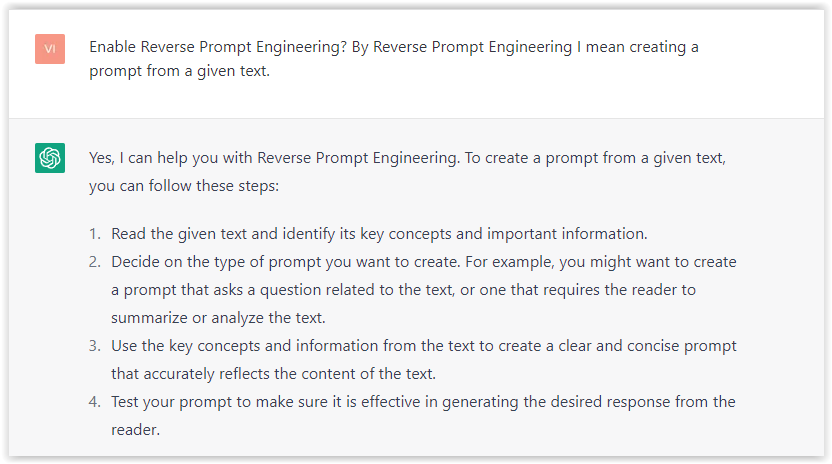 Screenshot from ChatGPT, March 2023
Screenshot from ChatGPT, March 2023You can test other GPT assistants available in the GPTs search engine if you want to use Google results.
Master Reverse Prompt Engineering
ChatGPT can be an excellent tool for reverse engineering prompts because it generates natural and engaging responses to any given input.
By analyzing the prompts generated by ChatGPT, it is possible to gain insight into the model’s underlying thought processes and decision-making strategies.
One key benefit of using ChatGPT to reverse engineer prompts is that the model is highly transparent in its decision-making.
This means that the reasoning and logic behind each response can be traced, making it easier to understand how the model arrives at its conclusions.
Once you’ve done this a few times for different types of content, you’ll gain insight into crafting more effective prompts.
Prepare Your ChatGPT For Generating Prompts
First, activate the reverse prompt engineering.
- Type the following prompt: “Enable Reverse Prompt Engineering? By Reverse Prompt Engineering I mean creating a prompt from a given text.”
 Screenshot from ChatGPT, March 2023
Screenshot from ChatGPT, March 2023ChatGPT is now ready to generate your prompt. You can test the product description in a new chatbot session and evaluate the generated prompt.
- Type: “Create a very technical reverse prompt engineering template for a product description about iPhone 11.”
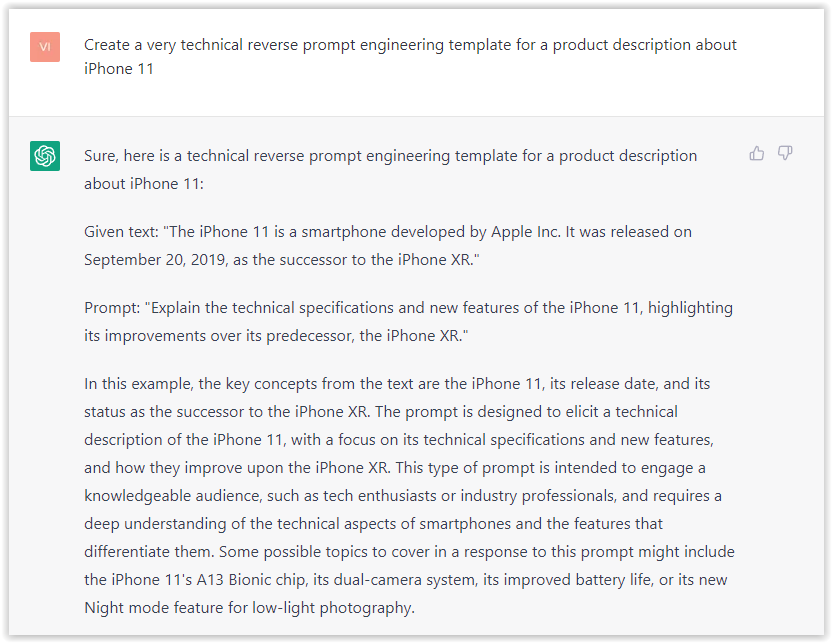 Screenshot from ChatGPT, March 2023
Screenshot from ChatGPT, March 2023The result is amazing. You can test with a full text that you want to reproduce. Here is an example of a prompt for selling a Kindle on Amazon.
- Type: “Reverse Prompt engineer the following {product), capture the writing style and the length of the text :
product =”
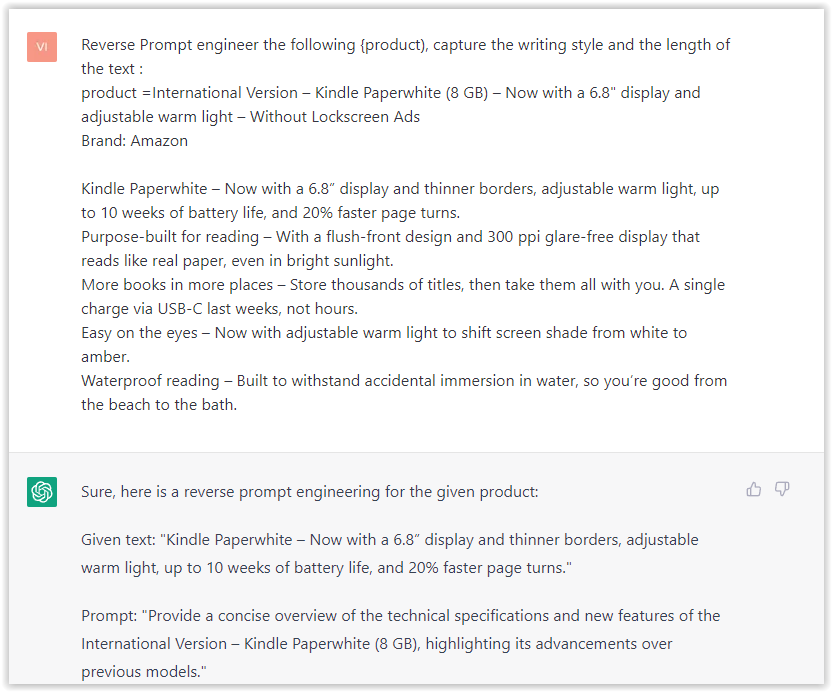 Screenshot from ChatGPT, March 2023
Screenshot from ChatGPT, March 2023I tested it on an SEJ blog post. Enjoy the analysis – it is excellent.
- Type: “Reverse Prompt engineer the following {text}, capture the tone and writing style of the {text} to include in the prompt :
text = all text coming from https://www.searchenginejournal.com/google-bard-training-data/478941/”
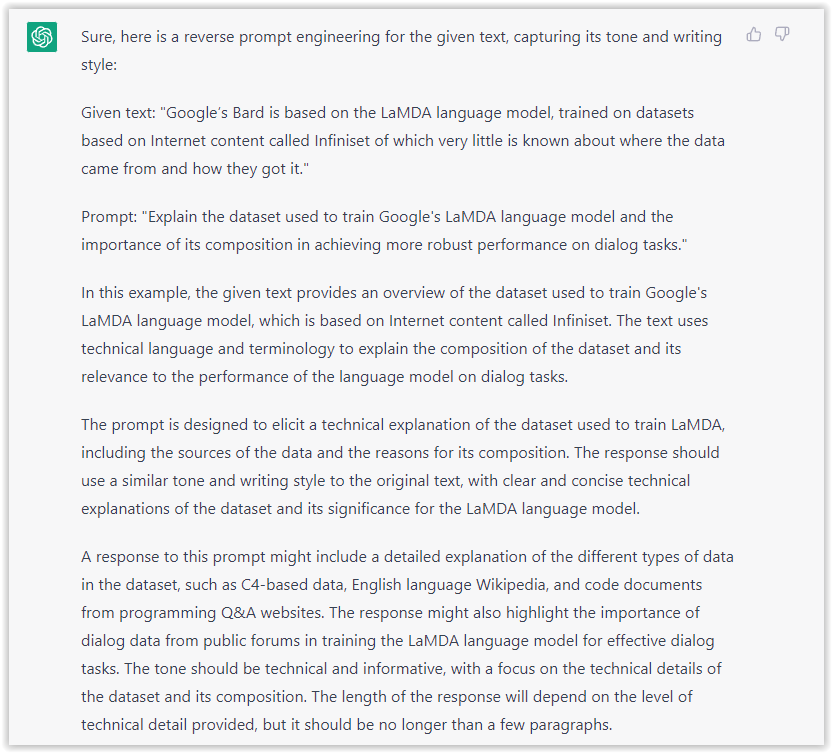 Screenshot from ChatGPT, March 2023
Screenshot from ChatGPT, March 2023But be careful not to use ChatGPT to generate your texts. It is just a personal assistant.
Go Deeper
Prompts and examples for SEO:
- Keyword research and content ideas prompt: “Provide a list of 20 long-tail keyword ideas related to ‘local SEO strategies’ along with brief content topic descriptions for each keyword.”
- Optimizing content for featured snippets prompt: “Write a 40-50 word paragraph optimized for the query ‘what is the featured snippet in Google search’ that could potentially earn the featured snippet.”
- Creating meta descriptions prompt: “Draft a compelling meta description for the following blog post title: ’10 Technical SEO Factors You Can’t Ignore in 2024′.”
Important Considerations:
- Always Fact-Check: While ChatGPT can be a helpful tool, it’s crucial to remember that it may generate inaccurate or fabricated information. Always verify any facts, statistics, or quotes generated by ChatGPT before incorporating them into your content.
- Maintain Control and Creativity: Use ChatGPT as a tool to assist your writing, not replace it. Don’t rely on it to do your thinking or create content from scratch. Your unique perspective and creativity are essential for producing high-quality, engaging content.
- Iteration is Key: Refine and revise the outputs generated by ChatGPT to ensure they align with your voice, style, and intended message.
Additional Prompts for Rewording and SEO:
– Rewrite this sentence to be more concise and impactful.
– Suggest alternative phrasing for this section to improve clarity.
– Identify opportunities to incorporate relevant internal and external links.
– Analyze the keyword density and suggest improvements for better SEO.
Remember, while ChatGPT can be a valuable tool, it’s essential to use it responsibly and maintain control over your content creation process.
Experiment And Refine Your Prompting Techniques
Writing effective prompts for ChatGPT is an essential skill for any SEO professional who wants to harness the power of AI-generated content.
Hopefully, the insights and examples shared in this article can inspire you and help guide you to crafting stronger prompts that yield high-quality content.
Remember to experiment with layering prompts, iterating on the output, and continually refining your prompting techniques.
This will help you stay ahead of the curve in the ever-changing world of SEO.
More resources:
Featured Image: Tapati Rinchumrus/Shutterstock
SEO
Measuring Content Impact Across The Customer Journey
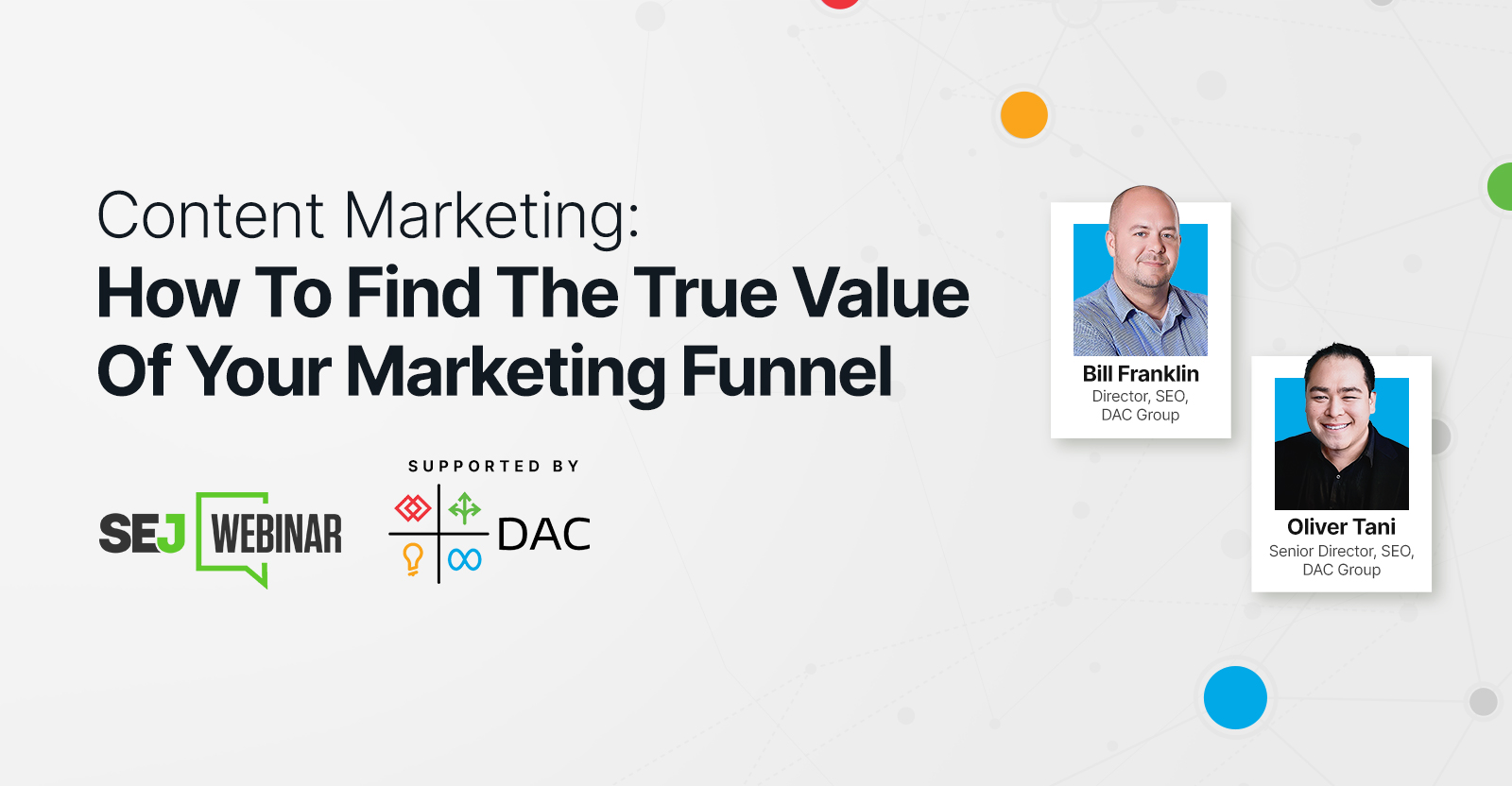
Understanding the impact of your content at every touchpoint of the customer journey is essential – but that’s easier said than done. From attracting potential leads to nurturing them into loyal customers, there are many touchpoints to look into.
So how do you identify and take advantage of these opportunities for growth?
Watch this on-demand webinar and learn a comprehensive approach for measuring the value of your content initiatives, so you can optimize resource allocation for maximum impact.
You’ll learn:
- Fresh methods for measuring your content’s impact.
- Fascinating insights using first-touch attribution, and how it differs from the usual last-touch perspective.
- Ways to persuade decision-makers to invest in more content by showcasing its value convincingly.
With Bill Franklin and Oliver Tani of DAC Group, we unravel the nuances of attribution modeling, emphasizing the significance of layering first-touch and last-touch attribution within your measurement strategy.
Check out these insights to help you craft compelling content tailored to each stage, using an approach rooted in first-hand experience to ensure your content resonates.
Whether you’re a seasoned marketer or new to content measurement, this webinar promises valuable insights and actionable tactics to elevate your SEO game and optimize your content initiatives for success.
View the slides below or check out the full webinar for all the details.
SEO
How to Find and Use Competitor Keywords
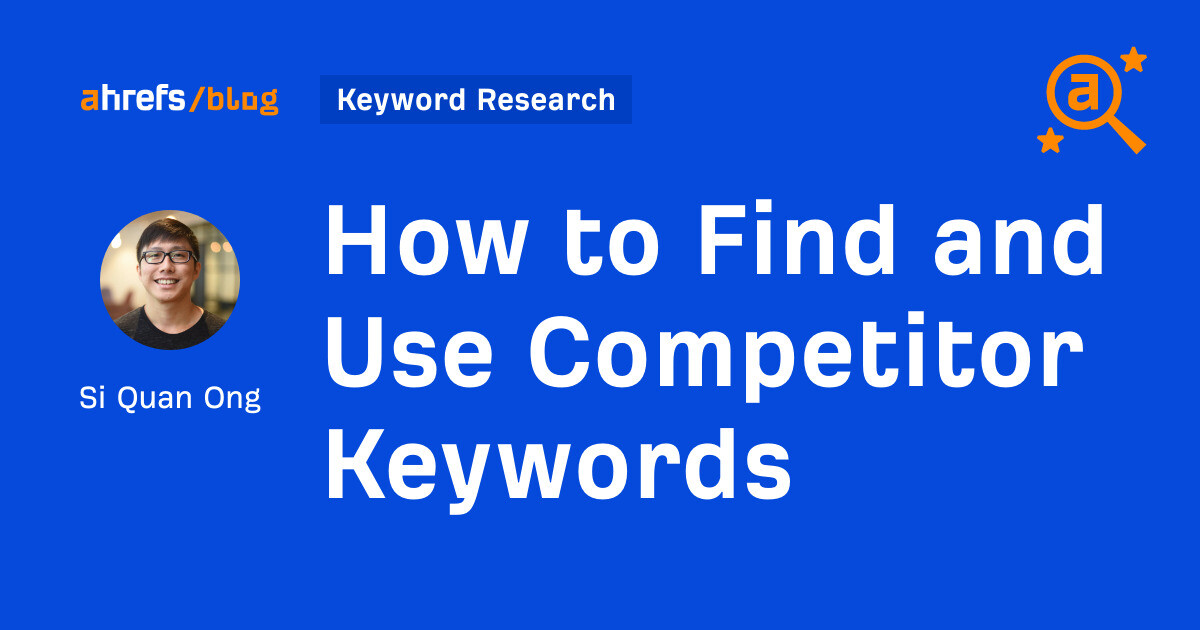
Competitor keywords are the keywords your rivals rank for in Google’s search results. They may rank organically or pay for Google Ads to rank in the paid results.
Knowing your competitors’ keywords is the easiest form of keyword research. If your competitors rank for or target particular keywords, it might be worth it for you to target them, too.
There is no way to see your competitors’ keywords without a tool like Ahrefs, which has a database of keywords and the sites that rank for them. As far as we know, Ahrefs has the biggest database of these keywords.
How to find all the keywords your competitor ranks for
- Go to Ahrefs’ Site Explorer
- Enter your competitor’s domain
- Go to the Organic keywords report
The report is sorted by traffic to show you the keywords sending your competitor the most visits. For example, Mailchimp gets most of its organic traffic from the keyword “mailchimp.”


Since you’re unlikely to rank for your competitor’s brand, you might want to exclude branded keywords from the report. You can do this by adding a Keyword > Doesn’t contain filter. In this example, we’ll filter out keywords containing “mailchimp” or any potential misspellings:
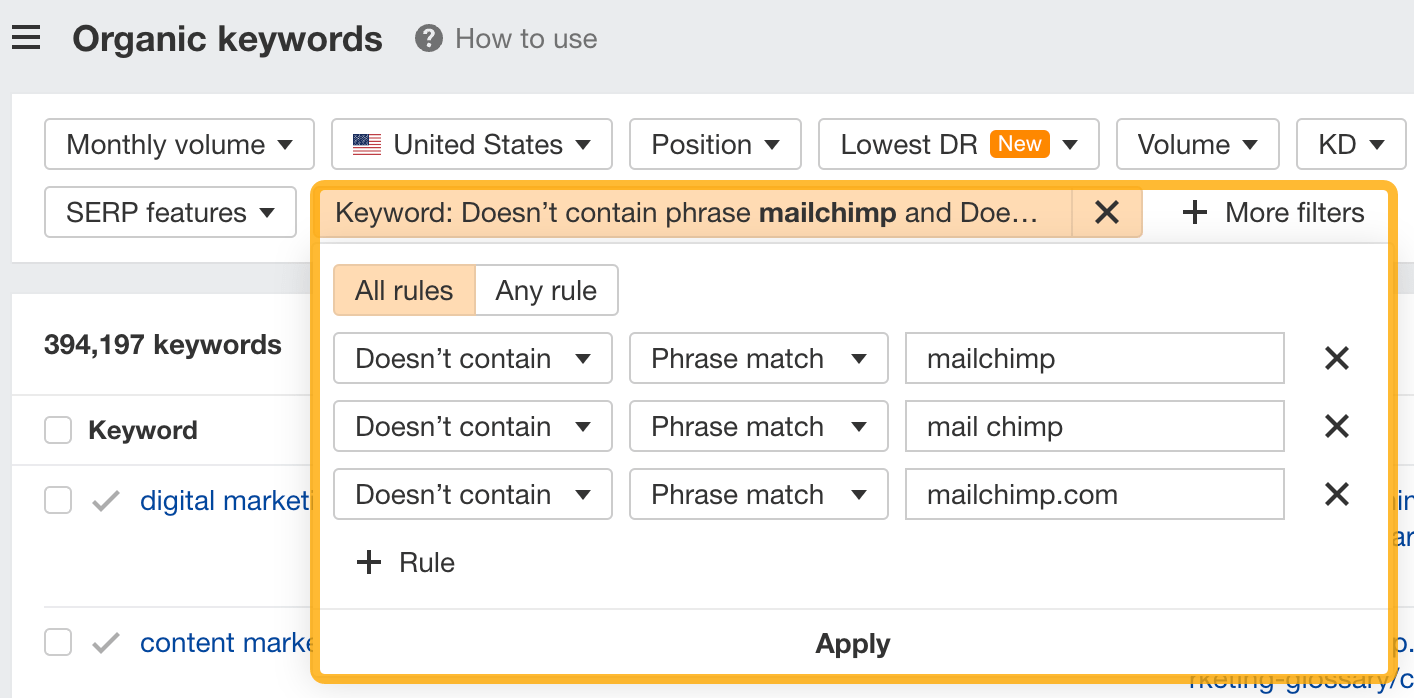

If you’re a new brand competing with one that’s established, you might also want to look for popular low-difficulty keywords. You can do this by setting the Volume filter to a minimum of 500 and the KD filter to a maximum of 10.
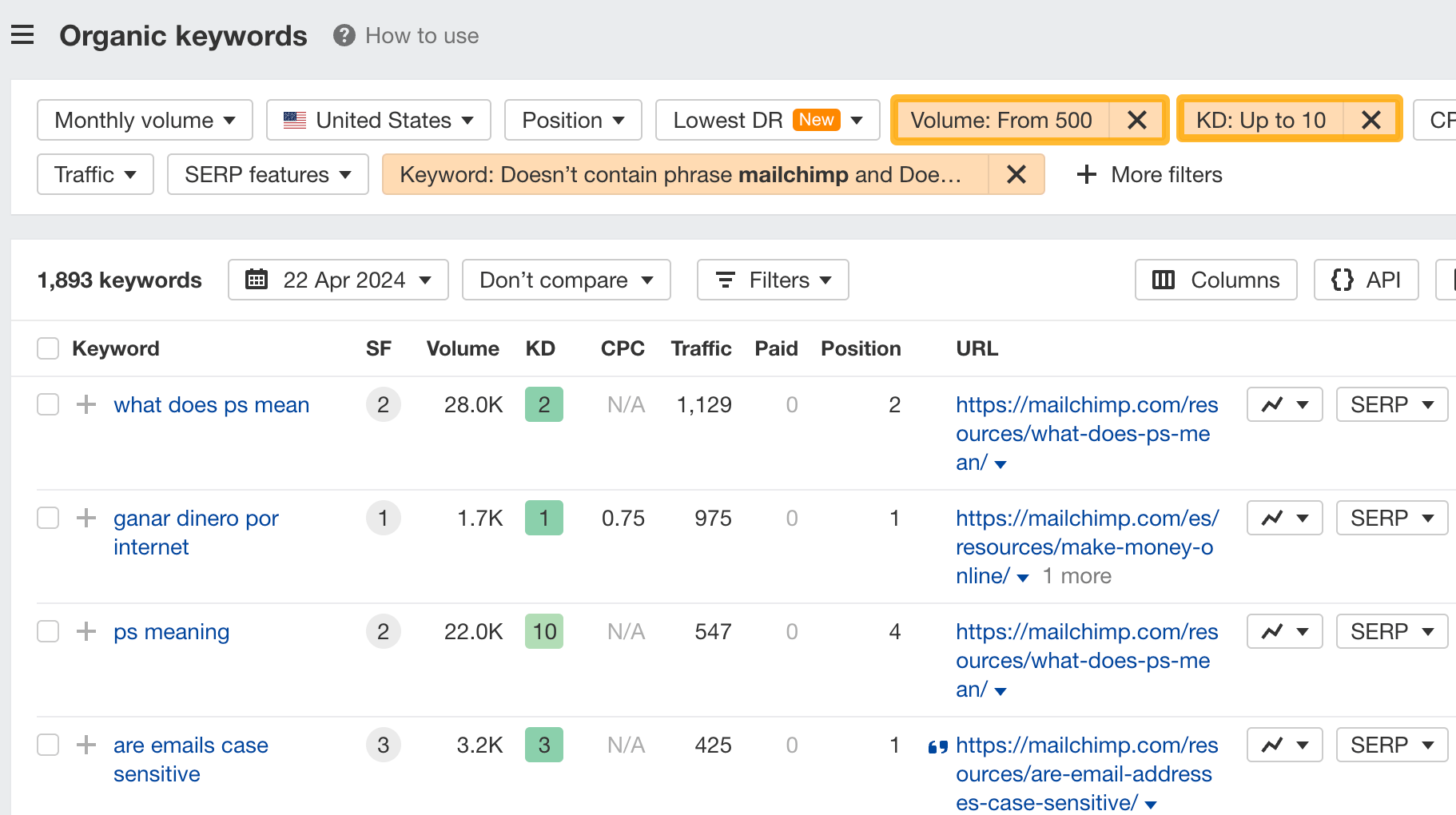

How to find keywords your competitor ranks for, but you don’t
- Go to Competitive Analysis
- Enter your domain in the This target doesn’t rank for section
- Enter your competitor’s domain in the But these competitors do section
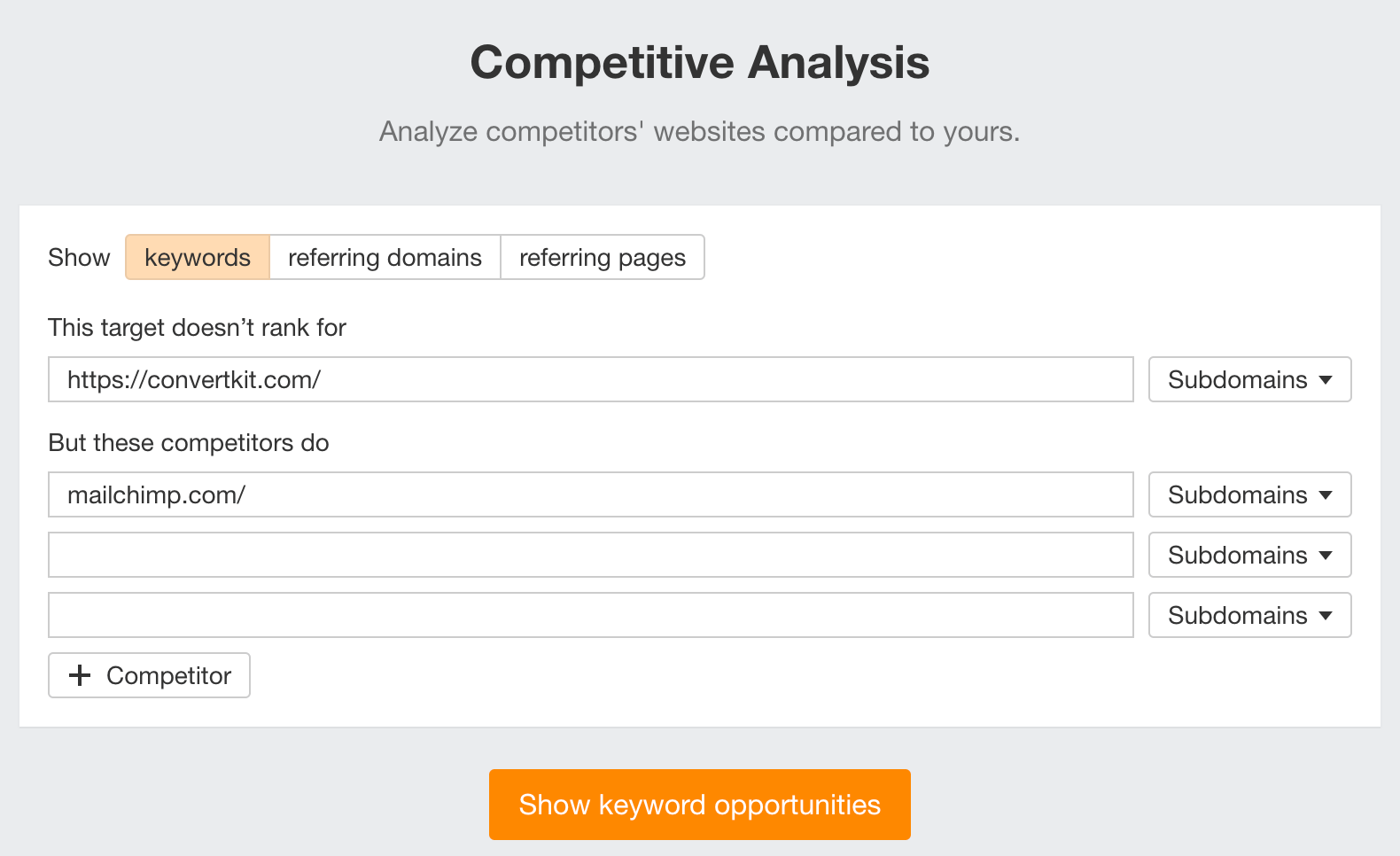

Hit “Show keyword opportunities,” and you’ll see all the keywords your competitor ranks for, but you don’t.
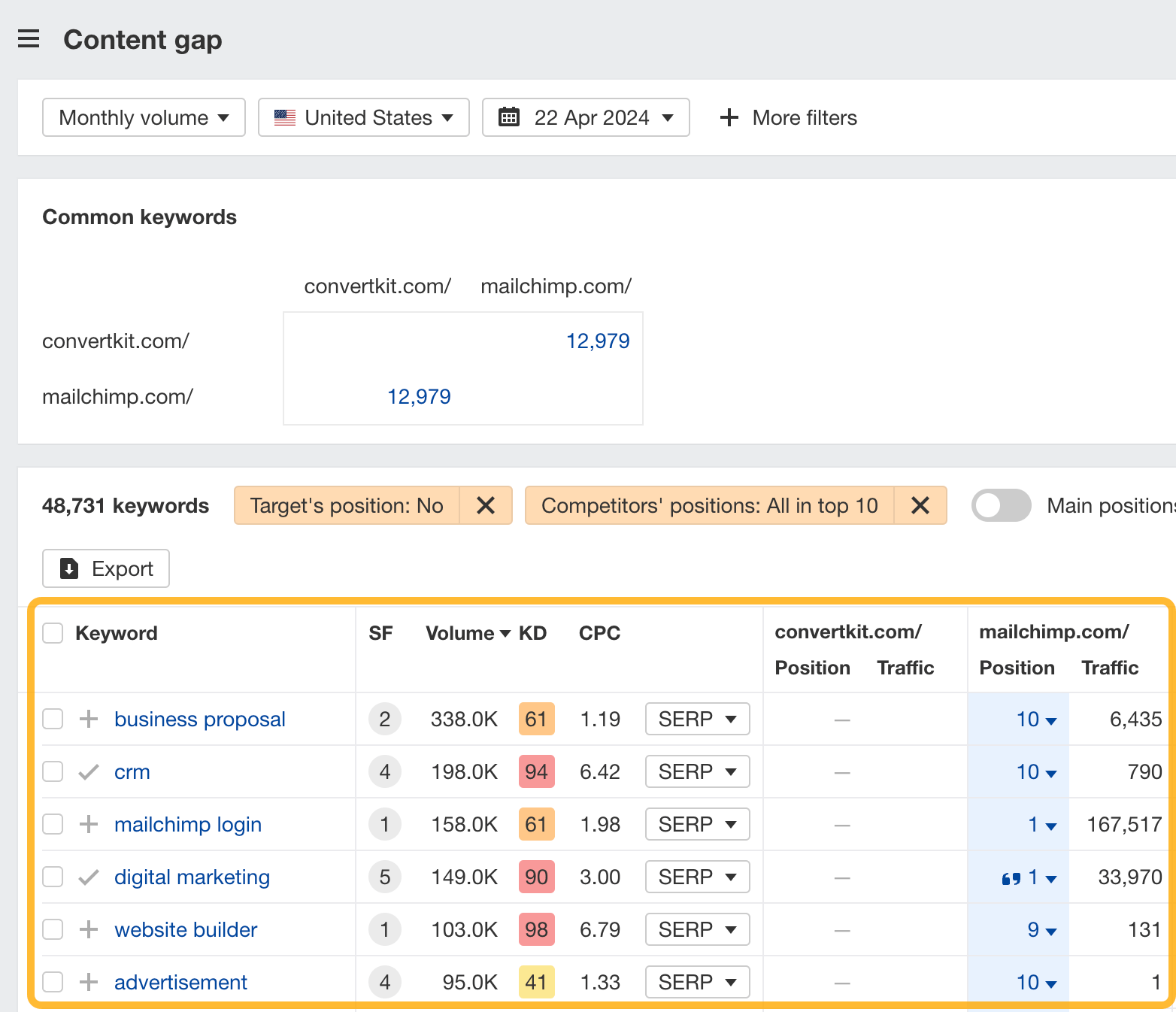

You can also add a Volume and KD filter to find popular, low-difficulty keywords in this report.
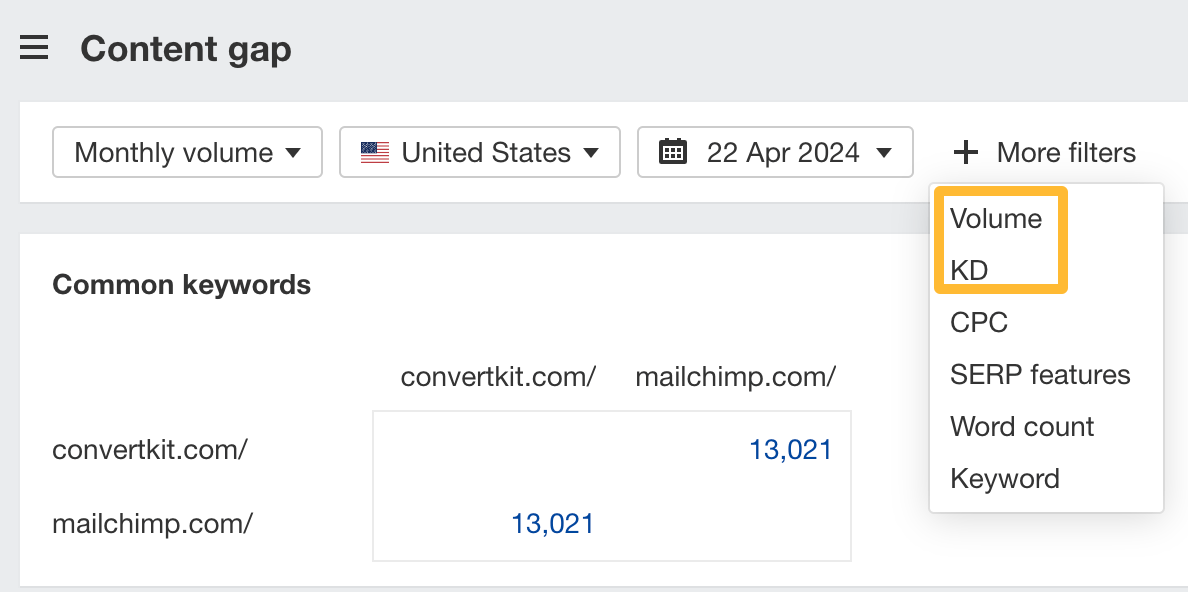

How to find keywords multiple competitors rank for, but you don’t
- Go to Competitive Analysis
- Enter your domain in the This target doesn’t rank for section
- Enter the domains of multiple competitors in the But these competitors do section
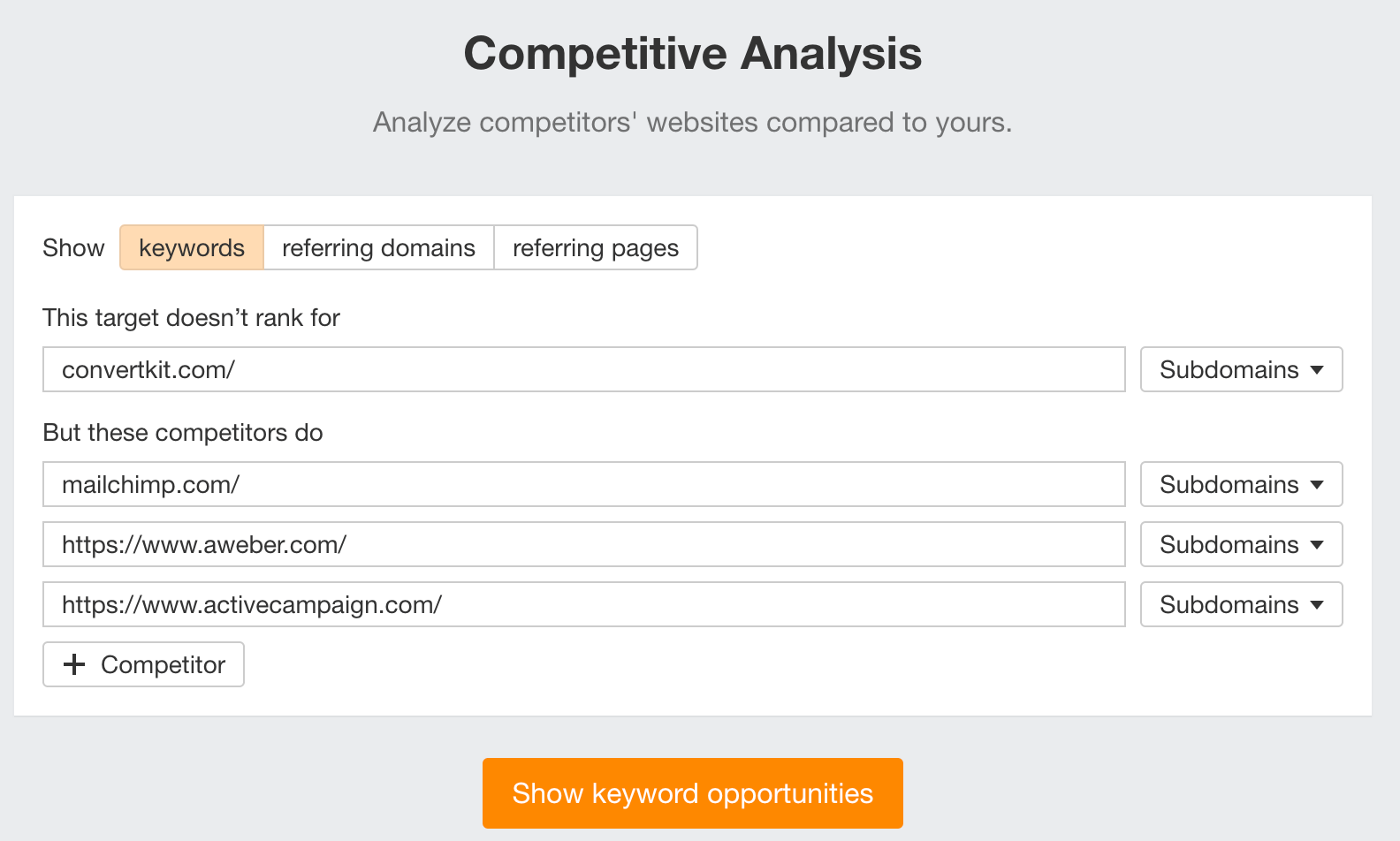

You’ll see all the keywords that at least one of these competitors ranks for, but you don’t.
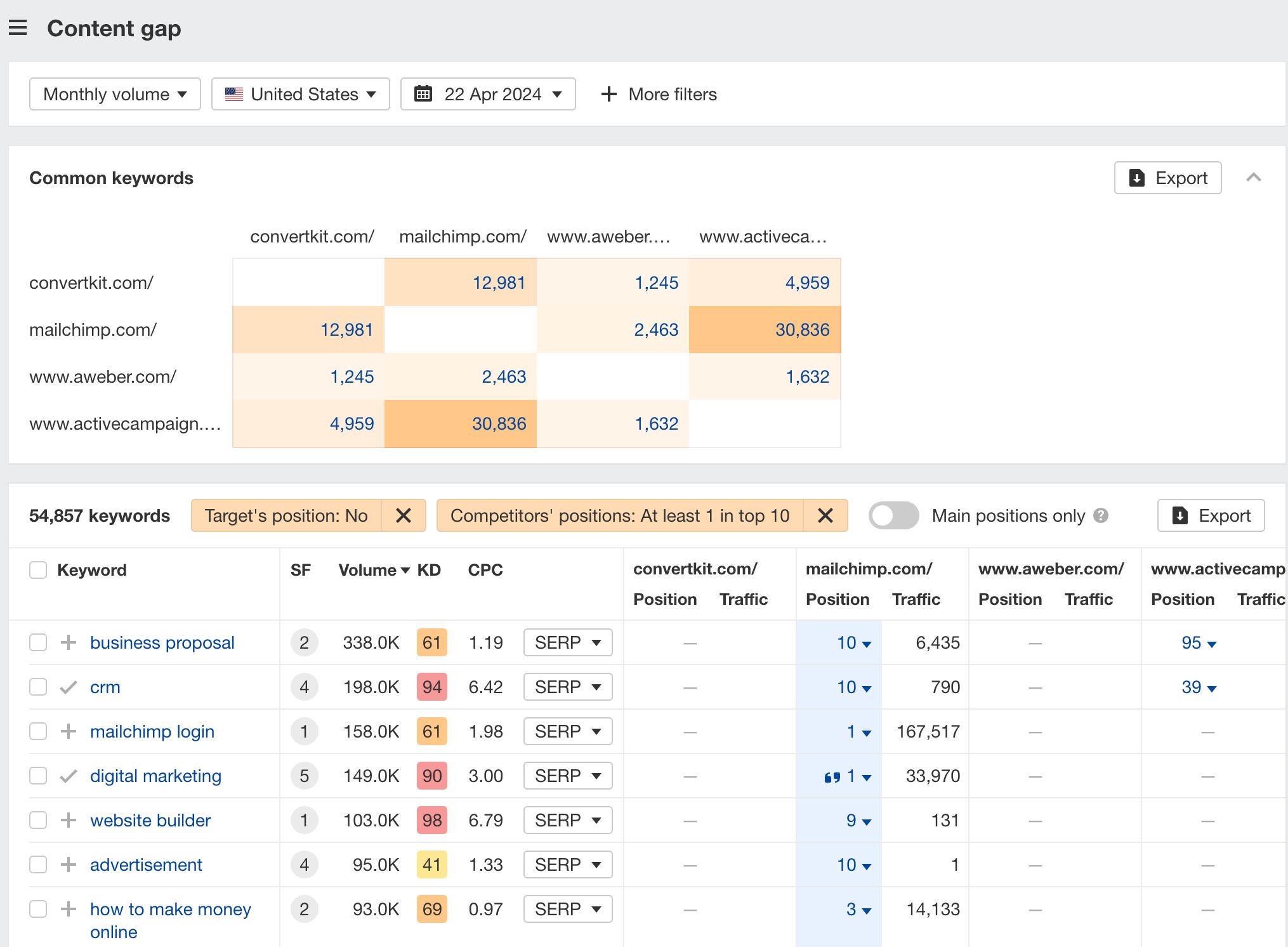

You can also narrow the list down to keywords that all competitors rank for. Click on the Competitors’ positions filter and choose All 3 competitors:
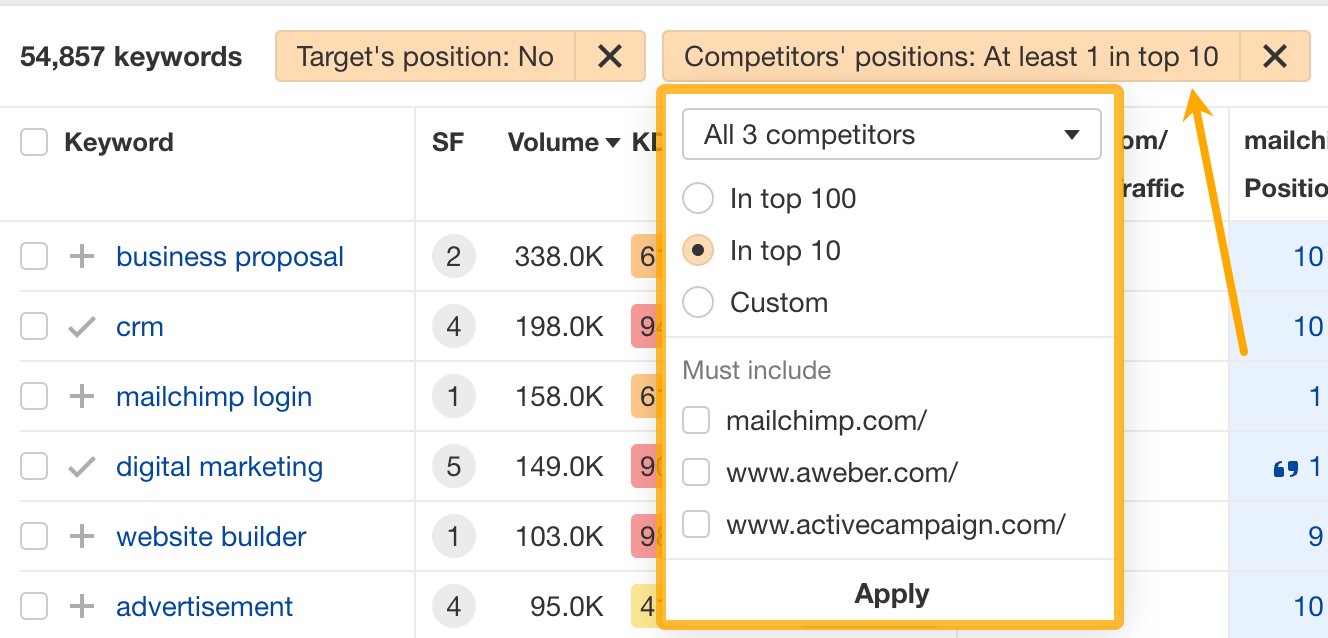

- Go to Ahrefs’ Site Explorer
- Enter your competitor’s domain
- Go to the Paid keywords report
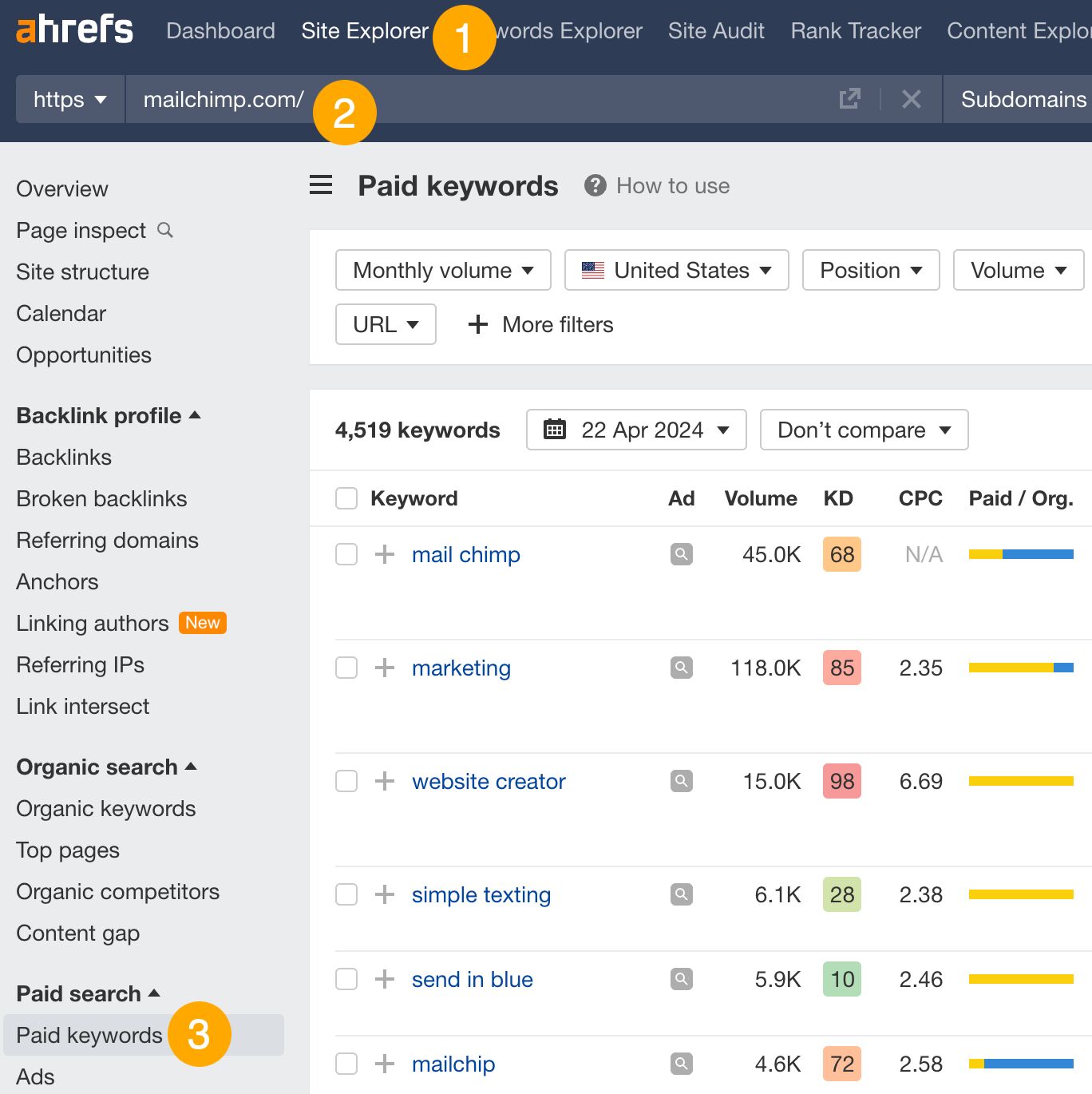

This report shows you the keywords your competitors are targeting via Google Ads.
Since your competitor is paying for traffic from these keywords, it may indicate that they’re profitable for them—and could be for you, too.
You know what keywords your competitors are ranking for or bidding on. But what do you do with them? There are basically three options.
1. Create pages to target these keywords
You can only rank for keywords if you have content about them. So, the most straightforward thing you can do for competitors’ keywords you want to rank for is to create pages to target them.
However, before you do this, it’s worth clustering your competitor’s keywords by Parent Topic. This will group keywords that mean the same or similar things so you can target them all with one page.
Here’s how to do that:
- Export your competitor’s keywords, either from the Organic Keywords or Content Gap report
- Paste them into Keywords Explorer
- Click the “Clusters by Parent Topic” tab
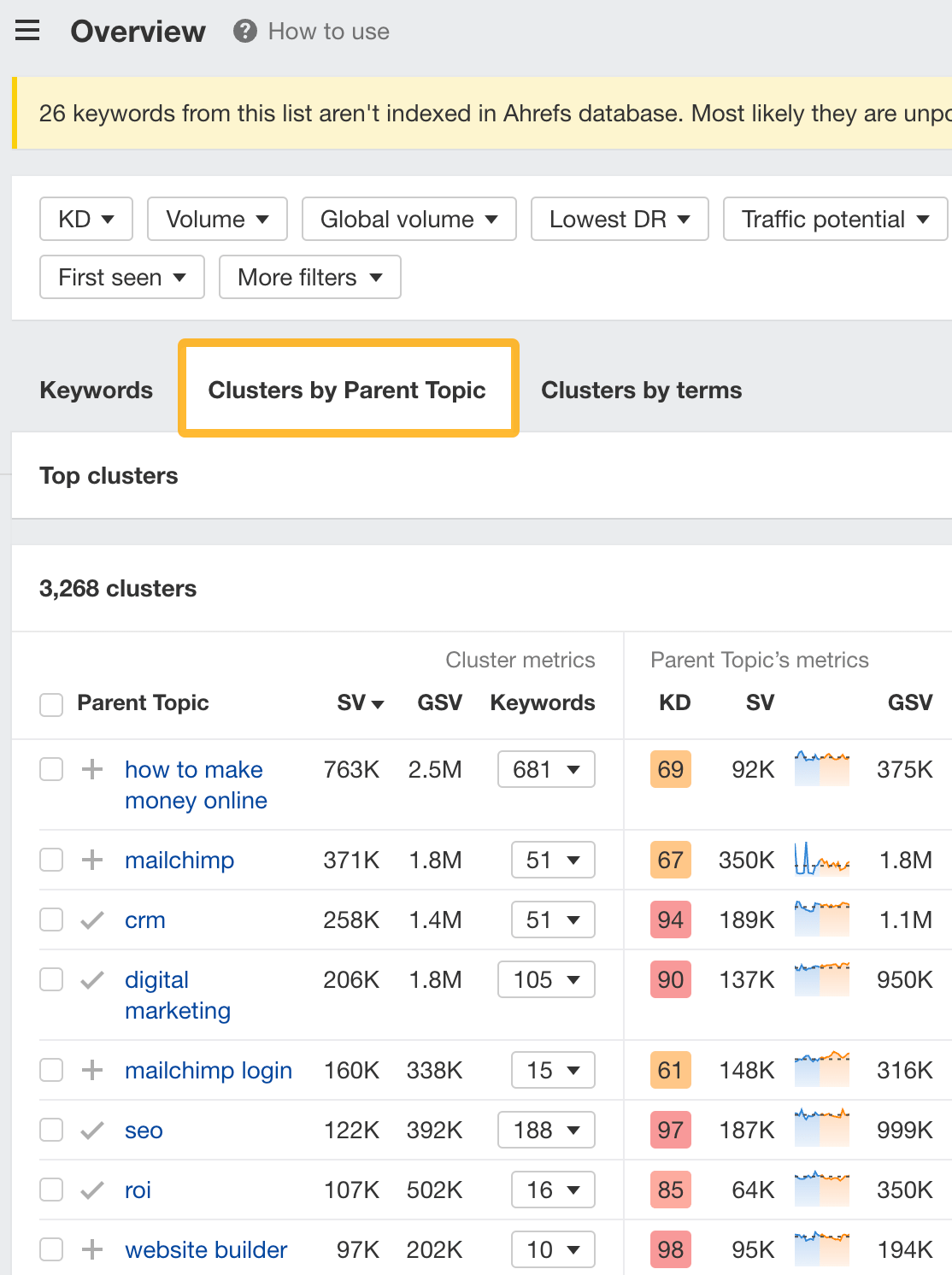

For example, MailChimp ranks for keywords like “what is digital marketing” and “digital marketing definition.” These and many others get clustered under the Parent Topic of “digital marketing” because people searching for them are all looking for the same thing: a definition of digital marketing. You only need to create one page to potentially rank for all these keywords.
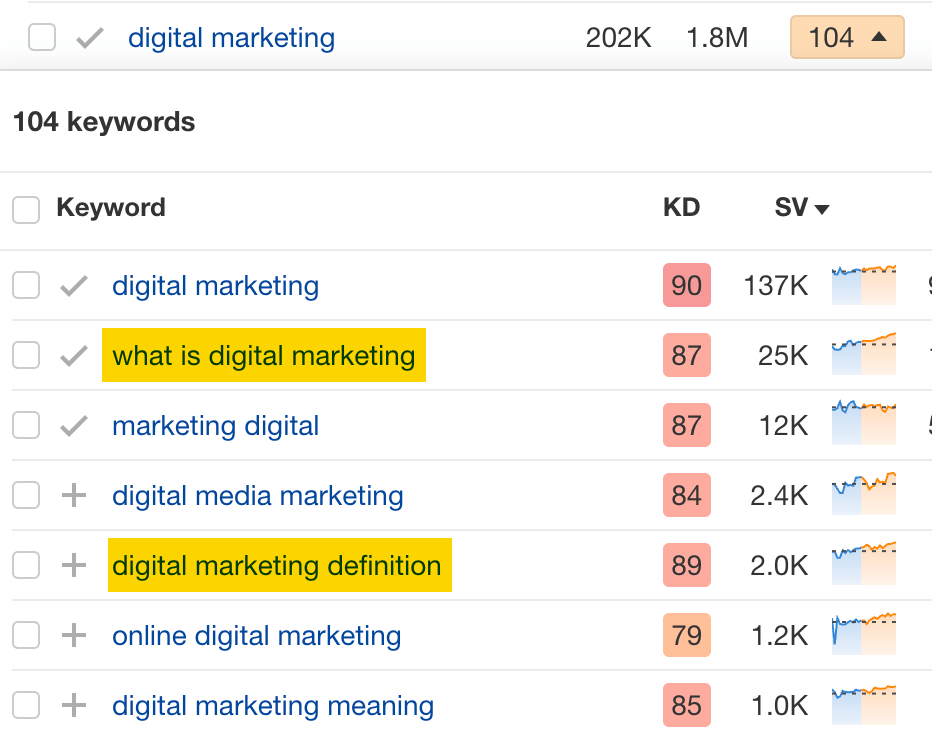

2. Optimize existing content by filling subtopics
You don’t always need to create new content to rank for competitors’ keywords. Sometimes, you can optimize the content you already have to rank for them.
How do you know which keywords you can do this for? Try this:
- Export your competitor’s keywords
- Paste them into Keywords Explorer
- Click the “Clusters by Parent Topic” tab
- Look for Parent Topics you already have content about
For example, if we analyze our competitor, we can see that seven keywords they rank for fall under the Parent Topic of “press release template.”


If we search our site, we see that we already have a page about this topic.


If we click the caret and check the keywords in the cluster, we see keywords like “press release example” and “press release format.”
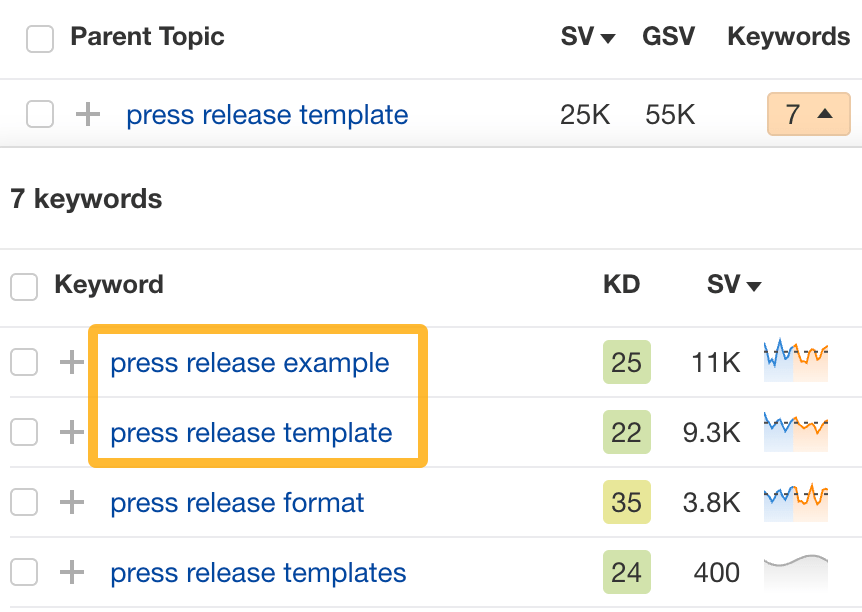

To rank for the keywords in the cluster, we can probably optimize the page we already have by adding sections about the subtopics of “press release examples” and “press release format.”
3. Target these keywords with Google Ads
Paid keywords are the simplest—look through the report and see if there are any relevant keywords you might want to target, too.
For example, Mailchimp is bidding for the keyword “how to create a newsletter.”


If you’re ConvertKit, you may also want to target this keyword since it’s relevant.
If you decide to target the same keyword via Google Ads, you can hover over the magnifying glass to see the ads your competitor is using.
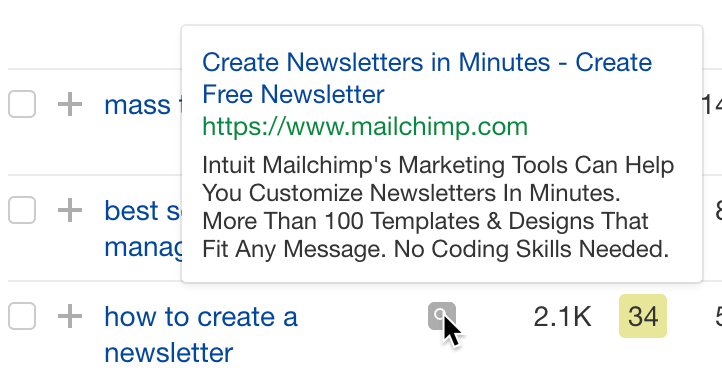

You can also see the landing page your competitor directs ad traffic to under the URL column.


Learn more
Check out more tutorials on how to do competitor keyword analysis:
-

 PPC6 days ago
PPC6 days ago19 Best SEO Tools in 2024 (For Every Use Case)
-

 MARKETING7 days ago
MARKETING7 days agoEcommerce evolution: Blurring the lines between B2B and B2C
-
SEARCHENGINES5 days ago
Daily Search Forum Recap: April 19, 2024
-
SEARCHENGINES6 days ago
Daily Search Forum Recap: April 18, 2024
-

 WORDPRESS5 days ago
WORDPRESS5 days agoHow to Make $5000 of Passive Income Every Month in WordPress
-

 SEO6 days ago
SEO6 days ago2024 WordPress Vulnerability Report Shows Errors Sites Keep Making
-

 WORDPRESS6 days ago
WORDPRESS6 days ago10 Amazing WordPress Design Resouces – WordPress.com News
-
WORDPRESS7 days ago
[GET] The7 Website And Ecommerce Builder For WordPress




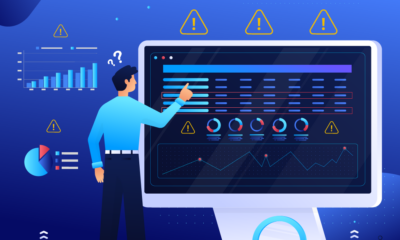



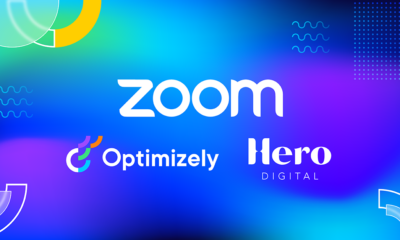

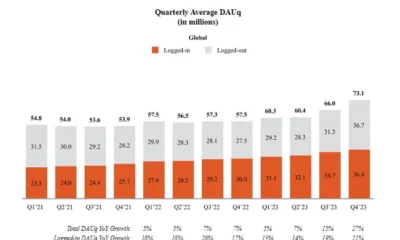





You must be logged in to post a comment Login